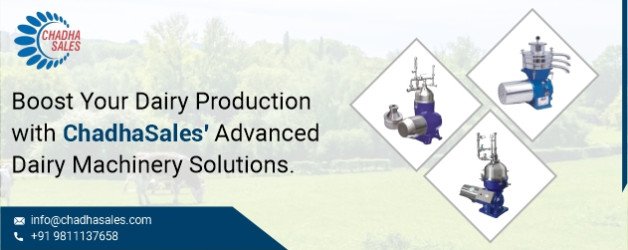Dairy machinery encompasses a wide range of equipment used in the production, processing, and packaging of dairy production such as milk, cheese, yogurt, and butter. These machines play a crucial role in ensuring efficiency, hygiene, and quality throughout the Dairy supply chain.
The Evolution of Dairy Machinery
The evolution of Dairy Machinery has undergone a remarkable journey from manual labor to advanced automation, driven by technological innovations and the pursuit of efficiency, hygiene, and product quality. The Dairy industry has continually aimed to meet consumer demands for safe, high-quality products while embracing innovation and sustainability as guiding principles.
Essential Types of Dairy Machinery
These essential types of Dairy Machinery play a vital role in modern dairy operations, facilitating efficient production, maintaining product quality, and meeting consumer demand for safe and nutritious dairy products.
- Milking Machines: Automated systems designed to extract milk from dairy animals efficiently and hygienically, reducing labor and ensuring animal welfare.
- Pasteurizers: Equipment used to heat milk to specific temperatures to eliminate harmful bacteria while preserving its nutritional properties, essential for producing safe dairy products.
- Homogenizers: Machinery that breaks down fat molecules in milk to create a uniform texture and prevent cream separation, ensuring consistent product quality in items like milk and ice cream.
- Separators: Devices used to separate cream from milk, allowing for the production of various dairy products with different fat contents, such as skim milk and cream.
- Paneer-Making Equipment: Includes vats, presses, curd knives, and molds used in the cheese production process, facilitating curd formation, pressing, shaping, and aging.
- Curd Processing Machines: Consists of incubation tanks, mixers, and packaging equipment necessary for fermenting milk and producing yogurt, ensuring consistency and quality in the final product.
- Butter Churns: Machinery that agitates cream to separate butterfat from buttermilk, producing butter as the end product for various culinary and commercial applications.
- Packaging Machinery: Includes filling machines, sealing equipment, and labeling systems used to package dairy products safely and efficiently, ensuring product freshness and shelf appeal.
The Role of Automation & IOT in Dairy Machinery
Automation and IoT (Internet of Things) technology are revolutionizing the dairy industry by streamlining processes, improving efficiency, and ensuring quality control throughout Dairy Machinery operations.
Automation:
- Efficiency Boost: Automated Dairy Machinery reduces manual labor, speeding up processes such as milking, pasteurization, and packaging.
- Consistency and Quality: Automation minimizes human error and variability, ensuring consistent product quality across batches.
- Labor Optimization: By automating repetitive tasks, dairy operations can reallocate human resources to more strategic roles, such as maintenance, quality control, and product development, thereby optimizing labor efficiency.
- Continuous Operations: Automated systems can operate around the clock, enabling dairy operations to meet demand fluctuations and maximize production capacity without interruptions.
IoT:
- Real-Time Monitoring: IoT sensors installed in Dairy Machinery enable real-time monitoring of crucial parameters such as temperature, pressure, and flow rates.
- Predictive Maintenance: IoT-enabled predictive maintenance systems analyze data from sensors to anticipate equipment failures before they occur.
- Data Analytics: IoT platforms collect and analyze data from various Dairy Machinery, providing valuable insights into production efficiency, product quality, and resource utilization.
- Quality Control: This real-time monitoring ensures adherence to quality standards and food safety regulations, safeguarding the integrity and safety of dairy products.
Maintenance & Hygiene of Dairy Machinery
Maintenance
Maintenance of Dairy Machinery is critical for ensuring equipment reliability, maximizing operational efficiency, and upholding product quality and safety standards. Detailed documentation of maintenance activities facilitates equipment history tracking and regulatory compliance.
By prioritizing regular maintenance practices, dairy operations can minimize downtime, optimize productivity, and uphold product quality and safety standards.
Hygiene
Maintaining proper hygiene in Dairy Machinery is paramount to ensure the safety and quality of dairy products. Hygiene maintenance should be integrated into routine equipment inspections and maintenance tasks to address any signs of wear or damage promptly.
Additionally, personnel hygiene practices, such as frequent handwashing and the use of protective clothing, should be emphasized.Through adherence to strict hygiene protocols and effective cleaning practices, dairy operations can uphold food safety standards and maintain the integrity of their products.
Economic & Environmental Benefits of Modern Dairy Machinery
Economic-
- Increased Efficiency: Modern Dairy Machinery reduces labor needs and streamlines production processes like milking, pasteurization, and packaging, leading to higher productivity and cost savings.
- Improved Productivity: Automated systems allow dairy operations to produce more products in less time, meeting demand and expanding market opportunities.
- Reduced Operational Costs: Efficiency gains result in lower labor, energy, and maintenance expenses, improving profitability and competitiveness.
- Enhanced Product Quality: Precise control of processing parameters ensures consistent product quality, enhancing consumer satisfaction and brand reputation, driving increased sales and revenue.
Environmental-
- Resource Efficiency: Modern Dairy Machinery optimizes water, energy, and raw material use, reducing waste and environmental impact.
- Reduced Emissions: Advanced machinery minimizes greenhouse gas emissions and air pollutants, contributing to a cleaner environment.
- Waste Reduction: Efficient processing methods and packaging technologies minimize food waste and environmental pollution.
- Environmental Compliance: Modern machinery meets stringent environmental standards, reducing regulatory risks and fines for non-compliance
Choosing the right Dairy Machinery for your farm or Processing Unit
When choosing Dairy Machinery for your farm, consider your specific needs, budget, and the equipment’s quality and reliability. Ensure compatibility with existing infrastructure and look for features like automation and energy efficiency. Also, factor in maintenance requirements, support services, and environmental impact. By balancing these considerations, you can select machinery that maximizes efficiency and productivity while aligning with your farm’s goals.
For Any Query, Please Fill Up the Below Form
Conclusion
In conclusion, Dairy Machinery plays a vital role in meeting consumer demands for safe and high-quality dairy products while advancing innovation and sustainability in the industry. Through continuous advancements and a commitment to excellence, dairy operations can enhance efficiency, productivity, and product quality while reducing environmental impact,ensuring a prosperous future for dairy operations.

